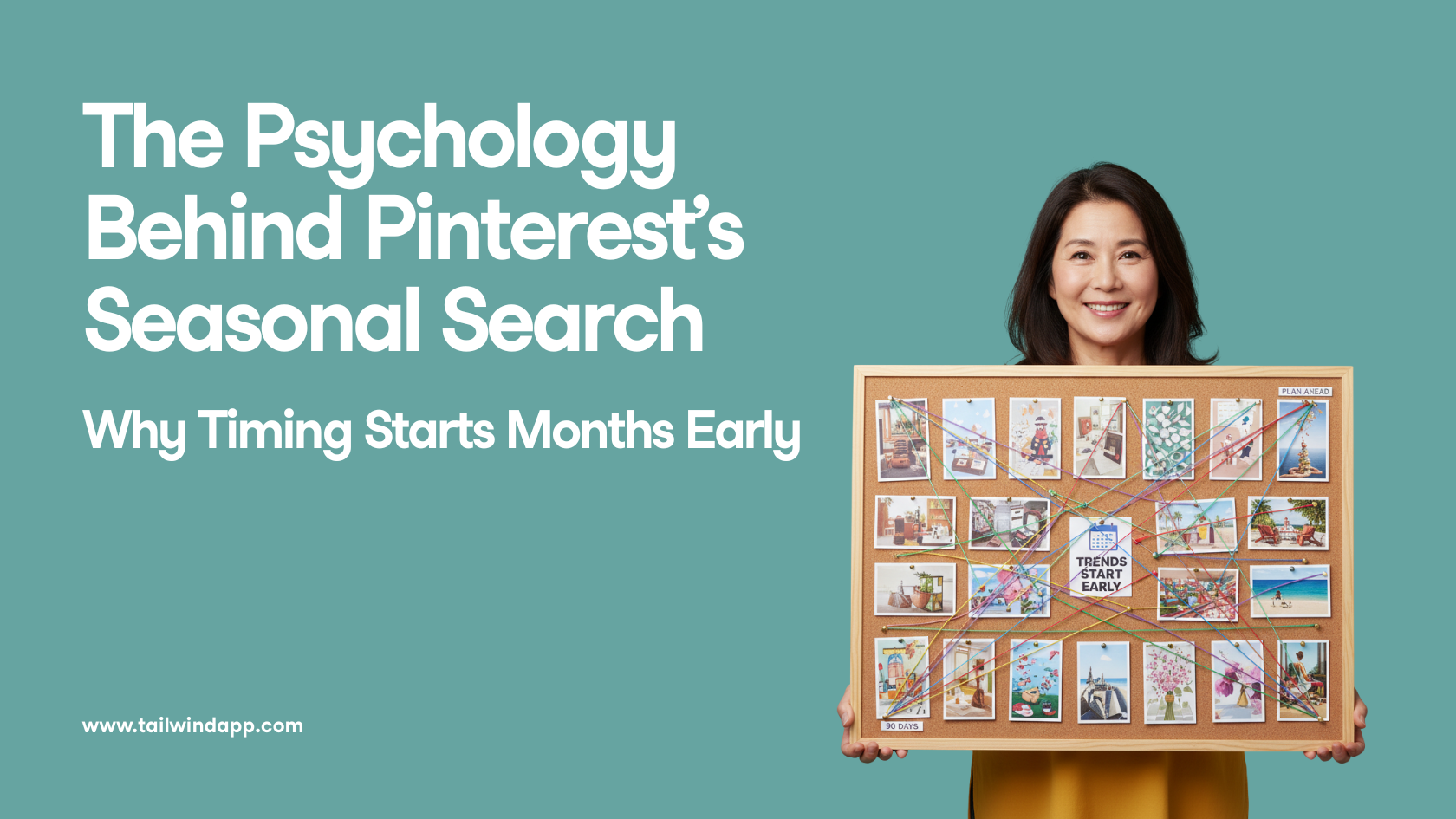
To define affiliate marketing means you have to first understand a rewards system. Whether your affiliate program is a business-to-business (B2B) program or a business-to-consumer (B2C) program, the idea is similar!
Affiliate Marketing Definition (The Easy Version):
Basically, you reward businesses and customers that “partner” with you, by paying them a commission fee for every conversion they’re responsible for.
In other words, you give them moo-lah for every one of their audience members who sees their promotion of your product and buys it! So, you’re paying for the leads they provide you.
Not all affiliate programs are built the same. Some are very interactive, and some are hands-off.
How much hand-holding and support you offer your affiliates to set them up for success is at your discretion. But what we’ve found through Tailwind’s affiliate program is the more you help your affiliates, the more they help you! Talk about a win-win.
And another win-win? There are plenty of affiliate network tools available to help you automate a ton of the work involved and focus on nurturing your affiliate partners.
How to Start an Affiliate Marketing Program in 6 Steps
Figuring out how to implement affiliate marketing into your business model doesn’t mean you have to reinvent the wheel.
Thankfully, there are many who have gone before you (like us, for example!). There are six basic steps we think are important to follow:
- Choosing Your Affiliate Network or Platform
- Creating Affiliate Performance Requirements
- Calculating Affiliate Commission Strategies
- Searching Out High-Quality Affiliates
- Spreading the Word About Your Affiliate Program
- Regularly Evaluating for Improvements of Your Affiliate Program
Read on for a step-by-step breakdown of each!
Step One: Choose Your Affiliate Program Network
Creating your own affiliate program starts with a choice between starting in-house, or using a network designed to help affiliate programs succeed.
If you have the time to fully manage an affiliate program, there’s nothing wrong with building and managing your program from the ground-up.
However, most business owners don’t! That’s where affiliate networks can really shine.
Many offer a complete affiliate marketing system that you can tap into and get started with for a fee. But the money, time, and headaches saved are worth it!
Plus, as your affiliate marketing program grows, you’ll have a lot more moving pieces and people to manage. An affiliate network can expand with your program a little more easily than an in-house version!
Some popular affiliate networks to consider include:
ShareASale

ShareASale is arguably one of the largest and trusted affiliate marketing platforms out there. It’s loved by affiliates and merchants alike!
Track clicks, create custom affiliate links, and manage multiple storefronts and commission rates, sans the headaches.
Spoiler: ShareASale is what Tailwind uses to manage our Affiliate Program.
Rakuten

Rakuten, once known as Linkshare, represents a wide range of reputable merchants.
They can be a little niche though, so make sure they are good fit for your brand, and that you’re likely to find quality affiliates that resonate with your ideal audience on this platform.
Some major pros: They have great customer service, offer cost per sale and cost per lead options, and have tracking software1
Commission Junction

Commission Junction is a great platform for established brands.
Affiliates have access to features like tracking software and a customizable dashboard to keep track of clicks, impressions, and conversions.
You can also set up both cost per lead and cost per sale options, depending on your particular product or service!
LeadDyno

LeadDyno is an affiliate management platform that offers great features for small owners growing their business to help you launch and manage affiliate programs.
They offer helpful features like automated emails, affiliate tracking, commission payment management, and social media marketing – that last one is a major plus!
TapAffiliate

TapAffiliate is cloud-based. It’s an affiliate software solution that you can use to manage your affiliate program like a boss—because you are the boss!—and grow both your brand and your program.
You can create custom commission structures and automate affiliate payouts with TapAffiliate.
You also have access to plenty of tools to manage your affiliates!
One interesting thing to note about TapAffiliate is that it supports MLM structures so that your affiliates can recruit new affiliates! That’s definitely working smarter, not harder when growing your program.
How the Affiliate Network Works
Affiliate networks are similar to a middleman (or a project manager).
They’re the liaison between you “the brand,” and “your partners,” the affiliates.
Affiliate networks take the weight of managing your program off your shoulders, by providing key services like:
- Sales tracking
- Commission payouts
- Vetting of partners
- Recruiting partners
Many affiliate networks are turn-key solutions for the busy business owner. Hands-down, they offer program growth potential that’s difficult to achieve with a home-grown program! Read on to figure out how to offer an affiliate program with either option.
Is It Better to Use an Affiliate Network or Build Your Own Affiliate Marketing Program from Scratch?
When figuring out how to get started with affiliate marketing, remember there are pros and cons to no matter what you do!
Pros and Cons for Affiliate Networks
Pros:
- You can build a roster of affiliates faster
- You have access to all the tools you need for tracking, paying commissions, and marketing
Cons:
- You have to pay a fee or fees to use the network
- Some platforms and networks may have a steeper learning curve than others
Pros and Cons for In-House Affiliate Programs
Pros:
- You have complete control over your program, structure and rules
- You don’t have to pay “middleman” fees and can pay more to your affiliates
Cons:
- You do all the work; setting up, tracking affiliate sales, making affiliate payments, providing marketing tools
- You have to build your own stable of affiliates and vet them yourself
Step Two: Create Affiliate Performance Requirements for Success
To set yourself up for success in the long term, you should create an affiliate program guide with performance requirements to be involved in your program.
If you require things like a base amount of commissionable transactions within a six month time frame and a marketing strategy on how partners plan to market their website and drive traffic to your site , it helps to separate the wheat from the chaff, so to speak.
True partners are 100% committed to earning both you and them money. If they aren’t committed they are wasting everyone’s time.
Step Three: Calculate Your Commission Strategy Realistically
Be realistic when figuring out your commission strategy.
Calculate what it costs you to acquire a new customer and still be profitable. Consider operational factors like shipping costs for physical products, for example.
Physical products require more money for fulfillment, so commission payouts are often lower.
Digital products and services often pay a higher commission percentage, because there is no cost to fulfillment.
On average, you should expect to pay between 1% up to 30% in commissions to your affiliates and decide if you plan to pay per lead or per click or per sale.
Good news: if you’re just starting or don’t have a lot of wiggle room in your budget, there are other things you can offer affiliates besides money.
For example, you could offer affiliates other things, like free products or discount codes in exchange for sending you customers.
Step Four: Search for High Quality Affiliates to Join Your Program
Although many of the larger affiliate networks draw a pool of qualified affiliates, that doesn’t mean you can’t acquire some great affiliates on your own.
Awesome affiliates are everywhere, you just have to find them. When vetting potential affiliates look for things like:

- Affiliates that have a platform– When they have their own platform with quality content, you know they are hardworking and committed to success.
- Affiliates who speak their mind and have a POV– People that speak their mind won’t offer products or services they don’t believe in. That gives your program credibility in the eyes of customers.
- Affiliates that understand marketing concepts– If they don’t understand marketing, how will they market your product or service?
- Affiliates who know how to show rather than tell in their messaging- Great affiliates are often great storytellers. It’s what draws customers in and prompts them to buy, as well as builds trust.
- Affiliates that have a strong sales funnel of their own– Most great affiliates will already be selling something of their own. If they aren’t they are probably just starting out and may not be the best fit for your business. Look for affiliates that are able to create content and guide their audience through a buying decision.
- Affiliates who are niche and complement your own products or services– It just makes sense to seek out affiliates within industries that are complementary to your business. When they promote your product, it’s something their established audience probably wants, needs or complements their lifestyle.
Step Five: Spread the Word!
Once you have your affiliate program set up, it’s time to start spreading the word.
You can post about your program on social media and send out an email if you have an email list. Consider running Instagram and Facebook ads to attract affiliates in your niche!
Share something with your contacts and network along the lines of,
“Hey, I’m starting an affiliate marketing program for my business. I would love to have you onboard as a partner. If you want to check out my affiliate marketing guide and see if it’s a good fit, shoot me a DM (or reply to this email) for more info and a peek at promo materials that are ready to rock!”
Step Six: Regularly Evaluate Your Affiliate Marketing Program
No affiliate program is a slam dunk right out of the gate. It takes time to build an amazing program. It also takes constant tweaking and improving.
You should regularly evaluate your program to ensure it’s the best it can be. Evaluate how well your affiliates are performing, the overall performance of the program, and how much it’s costing you to acquire new customers and new affiliates.
Look for ways to make improvements, treat your affiliates well, and set them up for maximum success. After all, when they succeed, so do you.
Conclusion: How Do I Start an Affiliate Marketing Program?
Starting an affiliate program can feel daunting. But if you follow the roadmap we’ve outlined above, you can be up and running a successful affiliate marketing program in no time!
Pin Me for Later :







